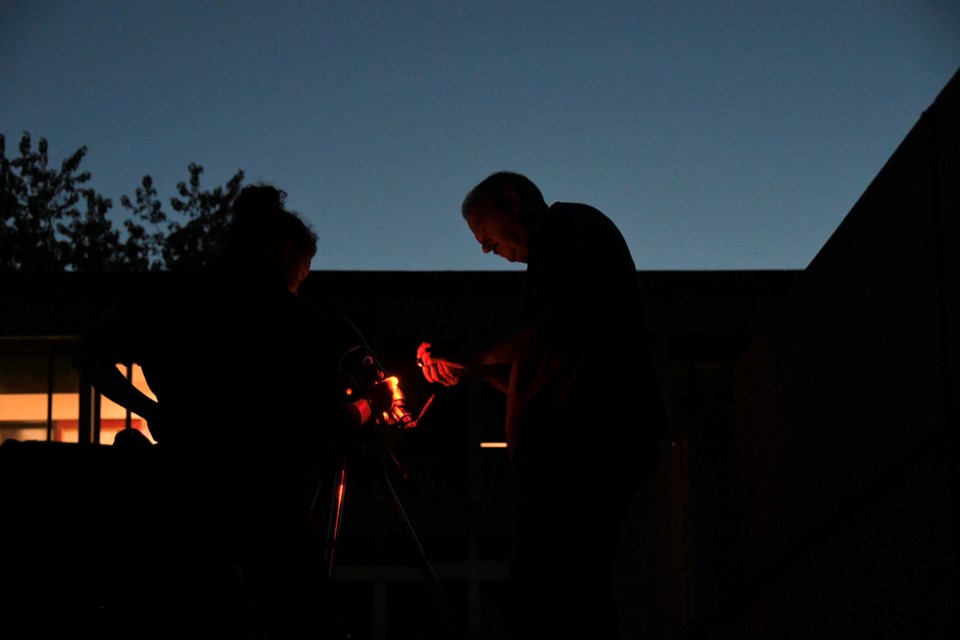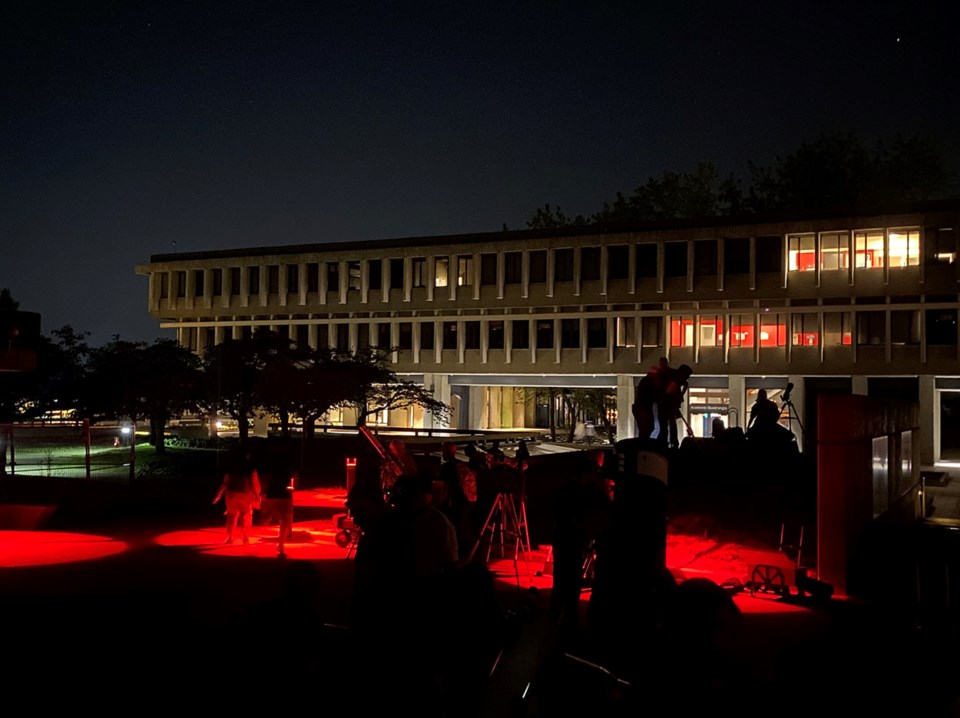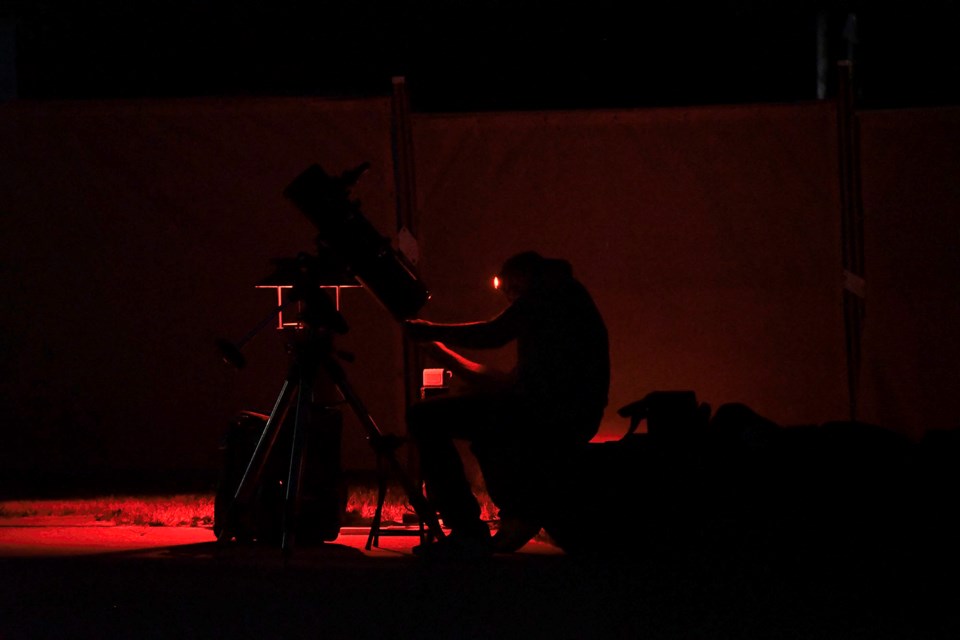When the Friday sun sets on Burnaby Mountain, and stars slink up from the deep blue horizon, a cluster of local sky watchers begins its weekly clear-night star party at Simon Fraser University’s Trottier Observatory.
But the event isn’t just for the very astrophysically minded folks of the earth.
Starry Nights, originally started in 2015, is a free event for all members of the public to join experienced volunteers and observatory staff to learn about the wonders of the cosmos, swap knowledge and share in astronomical beauty.
The event occurs every clear-skied Friday night throughout the year, and it’s a hub of activity and enthusiasm for those who love to gaze above and dream of matters beyond this world.
Last Friday, there were at least a dozen telescopes ready for public stargazing, most pointed at a different stretch of sky — though both Saturn and the Earth’s moon had more than two keen lenses pointed their way.
Members of the Vancouver Centre of the Royal Astronomer’s Society of Canada (RASC) join the fun, with members bringing their own telescopes and binoculars and inviting the public to peer through their equipment.
A good 45 minutes before the party starts, the astronomers are already pointing their telescopes to the stars and futzing with myriad gadgets to prepare for the night’s dance of space light.
The telescope queues are lined with a range of guests, from families with children to couples taking each other on dates.
Then there’s the observatory’s own giant telescope, which includes a periscope on one side, for visual observing and a camera on the other for imaging, according to Kyle Dalley, an outreach staff member at the Trottier Observatory.
Dally describes the Starry Nights experience as “enriching.”
“We’re constantly evolving, we’re trying to adapt for new things to put out for people,” Dally says.
He says the observatory wants to make learning about space accessible to all knowledge levels, from newbies to skilled experts.
‘Largest star party in Canada’
An average of 300 people come through the observatory each night, Dally says, with up to 360 visitors on the busiest night. And that number doesn’t include those people who don’t visit the observatory.
“I know of no other star party in Canada that’s this big,” says Alan Jones, president of the Vancouver RASC chapter.
“Do you want a buzz line for your article? ‘Largest star party in Canada.’ And it’s weekly, if the sky’s clear.”
Jones notes the observatory was the brainchild of Howard Trottier, an SFU physics professor whose family donated the funds for the telescope. Trottier began Starry Nights in his classes years before the observatory opened.
Jones’ own big telescope, part of which he fabricated himself, points to a five-billion-year-old cluster of hundreds of thousands of stars, 20,000 light years away and 145 light years across. It’s the Hercules globular cluster M13. Jones describes the cluster as a summer gem, like a sparkler. Through the telescope, it’s a firework of stars splashing out in the dark sky.
Jones says his favourite part of astronomy is the unending odyssey of exploration and curiosity.
“I’m still learning, that’s what drives me. That’s what everything is, whether it’s learning about optics and how telescopes work, or the objects we’re looking at.”

A full night of skygazing
Even at a quarter to midnight, the astronomers are still more than ready to discuss galaxies and nebulae beyond.
A few metres away from Jones’ telescope is father-daughter duo Rhys and Kayley Gibb, who have set up their telescopes on a grassy knoll in front of the observatory.
Burnaby high schooler Kayley’s interest in astronomy stemmed from the night sky stars she’d see after her softball games at Squint Lake Park.
“I’d always see the stars and everything, and my dad would, every day, point out one more star,” she said.
“And I’d start memorizing them and kind of getting with it. It started from there, then he got a telescope from work and started more getting into it, then going out more places just to see stars.”
Her dad got the telescope about five years ago, 30 years after his interest in astronomy began in his teens.
“I really enjoyed just being out and looking at the stars and seeing spectacular views that you normally wouldn’t get,” Rhys said.
Kayley said she sets herself a list of specific clusters and galaxies to find, and, like 18th-century comet-hunter Charles Messier, tracks down each space object with her telescope.
One of her favourite finds was the Owl Cluster, an array of stars in the constellation Cassiopeia that forms the shape of an owl, one eye brighter than the other.
Rhys’ achievement was finding every Messier object (the brightest, most prominent objects in the Northern Hemisphere) in a year.
All the astronomers seem to read the sky like musicians play off sheet notation.
With Arthur Erickson’s brutally symmetrical concrete buildings bearing down nearby, well, it’s hard not to feel like you’re on the planet Caprica, straight out of Battlestar Galactica.

With bright laser pointers, observatory staff and RASC volunteers pin down bright star Vega of the Lyre, then trace their lasers over various star patterns and space objects, be it Albireo, the double star, or the Summer Triangle of stars Deneb, Vega and Altair.
Everyone mentions, rather apologetically, that the light pollution is too much, that B.C. isn’t the best place for astronomy, that clear dark nights are rare. But no one seems to mind too much.
The sights are worth it.

Astrophotography
About three years ago, Miles van Yperen, a new member of RASC and Burnaby Mountain resident, wanted to learn how to take photos of far-off star stuff.
Equipped with some camera gear and YouTube, he’s now trained himself to create stunningly beautiful images of nebulae and more.
Last Friday, he was scouting the Swan Nebula.
“I didn’t know people could do that besides astronauts and NASA, you know? A regular Joe like me, I can take pictures of nebulas,” van Yperen says.
It takes about an hour and a half to set up his equipment — to tune it to the North Star and ready the camera filters, before the images begin to stream into his laptop, taking six-minute-long exposures. Then there’s the time-consuming process of post-production.
A retired visual effects instructor, van Yperen now creates imaginary visual worlds of composite 3D imagery blended with his own astrophotography.
(RASC hosts a webpage with astrophotography and imaging resources.)
For the observatory, Dally says, “It’s all about encouraging curiosity, asking questions about the world around us. … Why these things are in the sky, how they move, what do they mean?”
He said visitors ask questions that span from the scientifically unknown to the deep and philosophical.
“What’s on the other side of black holes?” (Answer: unknown.) “Does the universe have an edge?” “How old is the solar system?” “Is the solar system going to die?”
“You answer them as best as you can, and there’s some great questions where you go, ‘You know, I don’t know,’” Dally said.
“And that’s also a valuable answer to give as well, and it really shows that we are not all-knowing people. We’re still just as curious as you and learning alongside you as well.”
Starry Nights at SFU
When: Year-round, every clear Friday night from an hour after sunset to midnight. (Check @SFUTrottObs on Twitter for updates.)
Where: SFU Trottier Observatory (8888 University Dr., east of the academic quadrangle. Park in the east lot.)
Cost: Free





